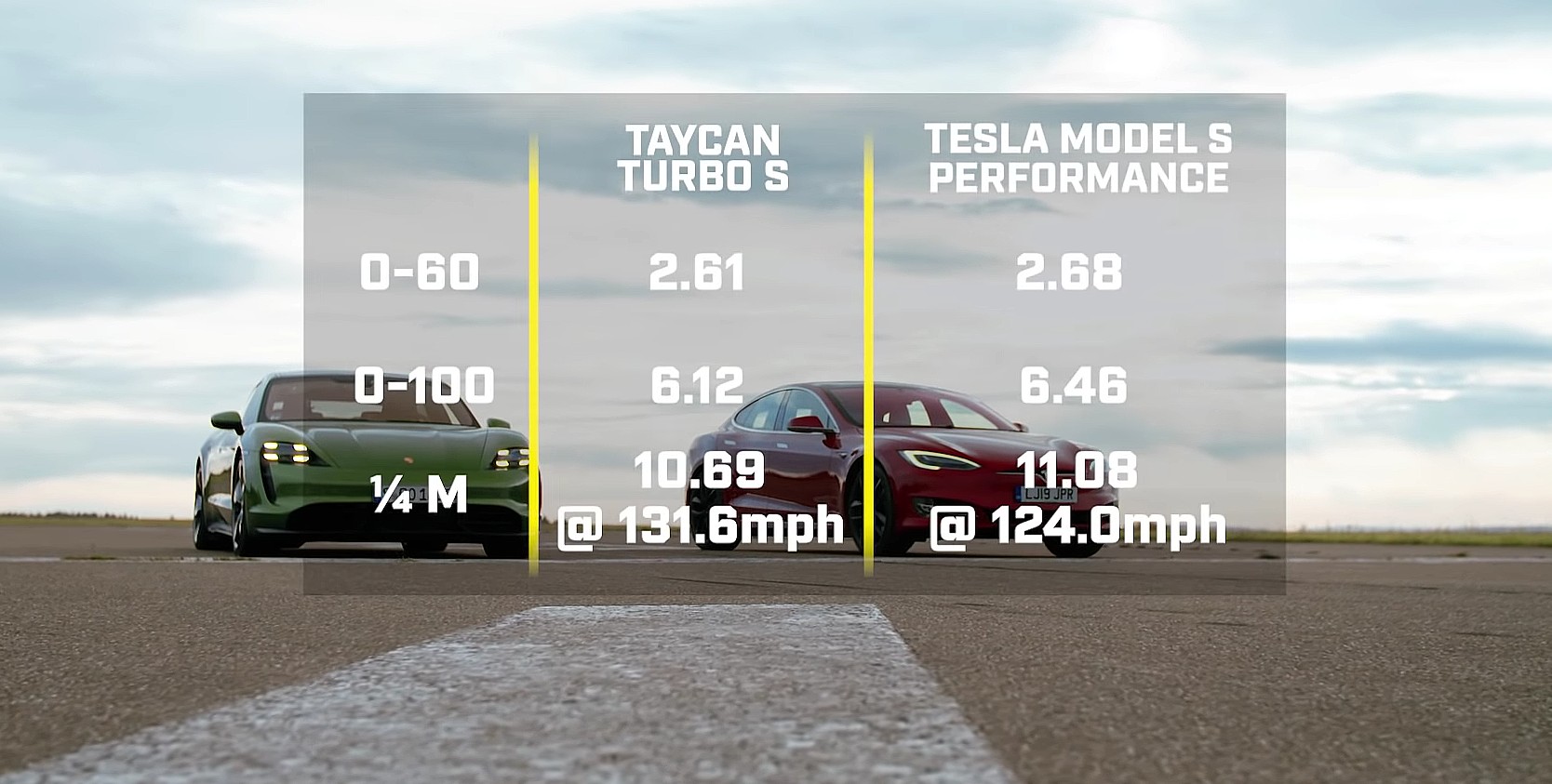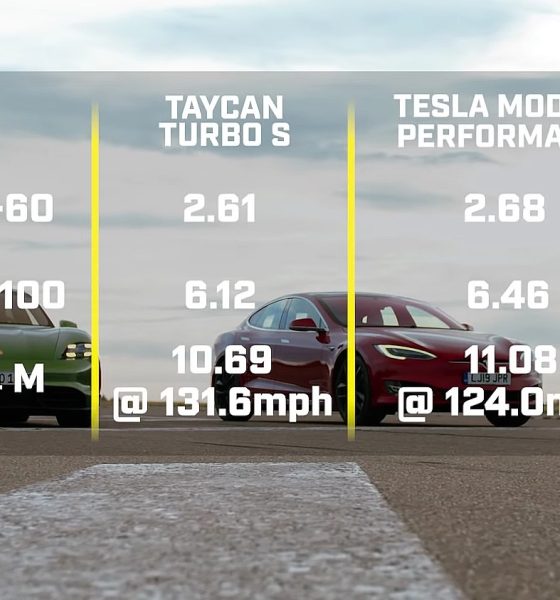

News
Porsche Taycan win against Tesla Model S is suspicious, says veteran drag racer
Just recently, motoring publication Top Gear posted a video comparing the Porsche Taycan Turbo S to the Tesla Model S Performance. The publication featured a drag race between the two vehicles which ended with the Taycan taking the win from the Model S. The quarter-mile race seemed to be a clean win for the Porsche, but according to a veteran drag racer, there are some aspects of the race that were, to say the least, suspicious.
Brooks of DragTimes has extensive experience on the drag strip, being the owner of vehicles like the McLaren 720S and the new Ford GT. With a garage filled with high-performance cars and innumerable straight-line races under his belt, Brooks knows a thing or two about drag racing. His experiences with his Model S P100D also make him a veteran Tesla owner who knows all the quirks of the all-electric sedan inside out when launching from a straight line.
With this in mind, the veteran drag racer noted that there seems to be several things that are wrong about the results of Top Gear‘s quarter-mile race between the Porsche Taycan Turbo S and the Tesla Model S Performance. The motoring publication listed the Model S’ 0-60 mph time at 2.68 seconds, its 0-100 mph at 6.46 seconds, and its quarter-mile time at 11.08 seconds at 124.0 mph. The DragTimes host noted that this immediately rings some alarm bells, as the Model S Performance is known to clock 10.6-second quarter-mile times regularly.
But it gets stranger. Looking at the figures listed by Top Gear after the two vehicles’ drag race, it appears that the publication basically copy-pasted the exact same performance figures of the Model S from a race against a Mercedes AMG E63S from 2017. This, according to Brooks, is highly suspicious, since the chances of a vehicle having the exact same 0-60 mph, 0-100 mph, quarter-mile time, and trap speed in two different drag races are incredibly thin.
Apart from this, the DragTimes host argued that the Model S which raced against the Taycan Turbo S did not seem to be in Launch Mode. This is because the Model S squats when Launch Mode is engaged, something that did not seem to happen in Top Gear‘s video. The motoring publication did not seem to engage the full capabilities of Ludicrous Plus Mode as well, as the graphics on the vehicle’s MCU and instrument cluster do not feature the same settings as a Model S with its maximum performance enabled.
Top Gear noted that the Porsche Taycan Turbo S completed the quarter-mile in 10.69 seconds, which is 0.39 seconds faster than the Model S’ 11.08-second quarter-mile time. Brooks noted that in drag races, a 0.39-second gap would usually correspond to about four car lengths. This is pretty odd since in the Top Gear video, the Taycan Turbo S was only one car length ahead of the Model S Performance when it crossed the quarter-mile mark.
If the DragTimes host’s observations are correct, then it means that Top Gear misrepresented the Tesla Model S in its recent comparative video against the Porsche Taycan Turbo S. This is unfortunate, as the two vehicles are actually neck-in-neck, and they do feature quarter-mile performance that can make an exciting drag race. The Porsche Taycan Turbo S is a great vehicle too, and its two-speed gearbox will likely give it an advantage over the Tesla Model S Performance at high speeds.
Simply put, the Porsche Taycan Turbo S is a worthy competitor that has the potential to win against a Raven Tesla Model S Performance with Launch Mode and Ludicrous Plus fair and square. Misrepresentations, whether intentional or not, only do Porsche an injustice. The Model S deserves better, and the Taycan Turbo S does too.
Watch Brook’s breakdown of Top Gear‘s Porsche Taycan Turbo S vs Tesla Model S Performance drag race in the video below.

News
Tesla FSD fleet is nearing 7 billion total miles, including 2.5 billion city miles
As can be seen on Tesla’s official FSD webpage, vehicles equipped with the system have now navigated over 6.99 billion miles.

Tesla’s Full Self-Driving (Supervised) fleet is closing in on almost 7 billion total miles driven, as per data posted by the company on its official FSD webpage.
These figures hint at the massive scale of data fueling Tesla’s rapid FSD improvements, which have been quite notable as of late.
FSD mileage milestones
As can be seen on Tesla’s official FSD webpage, vehicles equipped with the system have now navigated over 6.99 billion miles. Tesla owner and avid FSD tester Whole Mars Catalog also shared a screenshot indicating that from the nearly 7 billion miles traveled by the FSD fleet, more than 2.5 billion miles were driven inside cities.
City miles are particularly valuable for complex urban scenarios like unprotected turns, pedestrian interactions, and traffic lights. This is also the difference-maker for FSD, as only complex solutions, such as Waymo’s self-driving taxis, operate similarly on inner-city streets. And even then, incidents such as the San Francisco blackouts have proven challenging for sensor-rich vehicles like Waymos.
Tesla’s data edge
Tesla has a number of advantages in the autonomous vehicle sector, one of which is the size of its fleet and the number of vehicles training FSD on real-world roads. Tesla’s nearly 7 billion FSD miles then allow the company to roll out updates that make its vehicles behave like they are being driven by experienced drivers, even if they are operating on their own.
So notable are Tesla’s improvements to FSD that NVIDIA Director of Robotics Jim Fan, after experiencing FSD v14, noted that the system is the first AI that passes what he described as a “Physical Turing Test.”
“Despite knowing exactly how robot learning works, I still find it magical watching the steering wheel turn by itself. First it feels surreal, next it becomes routine. Then, like the smartphone, taking it away actively hurts. This is how humanity gets rewired and glued to god-like technologies,” Fan wrote in a post on X.
News
Tesla starts showing how FSD will change lives in Europe
Local officials tested the system on narrow country roads and were impressed by FSD’s smooth, human-like driving, with some calling the service a game-changer for everyday life in areas that are far from urban centers.

Tesla has launched Europe’s first public shuttle service using Full Self-Driving (Supervised) in the rural Eifelkreis Bitburg-Prüm region of Germany, demonstrating how the technology can restore independence and mobility for people who struggle with limited transport options.
Local officials tested the system on narrow country roads and were impressed by FSD’s smooth, human-like driving, with some calling the service a game-changer for everyday life in areas that are far from urban centers.
Officials see real impact on rural residents
Arzfeld Mayor Johannes Kuhl and District Administrator Andreas Kruppert personally tested the Tesla shuttle service. This allowed them to see just how well FSD navigated winding lanes and rural roads confidently. Kruppert said, “Autonomous driving sounds like science fiction to many, but we simply see here that it works totally well in rural regions too.” Kuhl, for his part, also noted that FSD “feels like a very experienced driver.”
The pilot complements the area’s “Citizen Bus” program, which provides on-demand rides for elderly residents who can no longer drive themselves. Tesla Europe shared a video of a demonstration of the service, highlighting how FSD gives people their freedom back, even in places where public transport is not as prevalent.
What the Ministry for Economic Affairs and Transport says
Rhineland-Palatinate’s Minister Daniela Schmitt supported the project, praising the collaboration that made this “first of its kind in Europe” possible. As per the ministry, the rural rollout for the service shows FSD’s potential beyond major cities, and it delivers tangible benefits like grocery runs, doctor visits, and social connections for isolated residents.
“Reliable and flexible mobility is especially vital in rural areas. With the launch of a shuttle service using self-driving vehicles (FSD supervised) by Tesla in the Eifelkreis Bitburg-Prüm, an innovative pilot project is now getting underway that complements local community bus services. It is the first project of its kind in Europe.
“The result is a real gain for rural mobility: greater accessibility, more flexibility and tangible benefits for everyday life. A strong signal for innovation, cooperation and future-oriented mobility beyond urban centers,” the ministry wrote in a LinkedIn post.
News
Tesla China quietly posts Robotaxi-related job listing
Tesla China is currently seeking a Low Voltage Electrical Engineer to work on circuit board design for the company’s autonomous vehicles.

Tesla has posted a new job listing in Shanghai explicitly tied to its Robotaxi program, fueling speculation that the company is preparing to launch its dedicated autonomous ride-hailing service in China.
As noted in the listing, Tesla China is currently seeking a Low Voltage Electrical Engineer to work on circuit board design for the company’s autonomous vehicles.
Robotaxi-specific role
The listing, which was shared on social media platform X by industry watcher @tslaming, suggested that Tesla China is looking to fill the role urgently. The job listing itself specifically mentions that the person hired for the role will be working on the Low Voltage Hardware team, which would design the circuit boards that would serve as the nervous system of the Robotaxi.
Key tasks for the role, as indicated in the job listing, include collaboration with PCB layout, firmware, mechanical, program management, and validation teams, among other responsibilities. The role is based in Shanghai.
China Robotaxi launch
China represents a massive potential market for robotaxis, with its dense urban centers and supportive policies in select cities. Tesla has limited permission to roll out FSD in the country, though despite this, its vehicles have been hailed as among the best in the market when it comes to autonomous features. So far, at least, it appears that China supports Tesla’s FSD and Robotaxi rollout.
This was hinted at in November, when Tesla brought the Cybercab to the 8th China International Import Expo (CIIE) in Shanghai, marking the first time that the autonomous two-seater was brought to the Asia-Pacific region. The vehicle, despite not having a release date in China, received a significant amount of interest among the event’s attendees.








